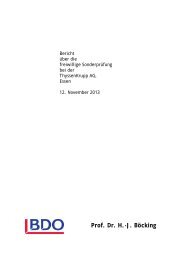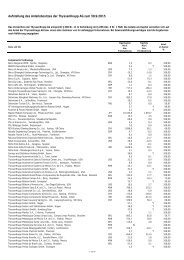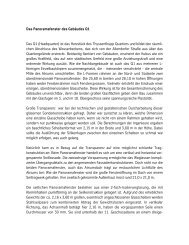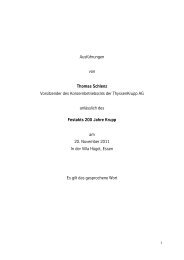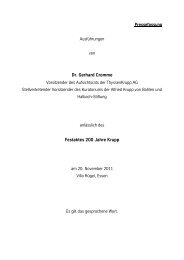PDF (10.9MB) - ThyssenKrupp AG
PDF (10.9MB) - ThyssenKrupp AG
PDF (10.9MB) - ThyssenKrupp AG
Create successful ePaper yourself
Turn your PDF publications into a flip-book with our unique Google optimized e-Paper software.
3.6 Consolidated financial statements Notes to the consolidated financial statements<br />
Cumulative other comprehensive income<br />
The equity line item “Cumulative other comprehensive income”<br />
includes changes in the equity of the Group that were not recognized in<br />
the consolidated statement of income of the period, except those<br />
resulting from investments by owners and distributions to owners.<br />
Cumulative other comprehensive income includes foreign currency<br />
translation adjustments, unrealized holding gains and losses on<br />
available-for-sale financial assets and on derivative financial<br />
instruments as well as the share of the other comprehensive income of<br />
associates and joint ventures accounted for using the equity method.<br />
Actuarial gains and losses are reported in retained earnings in the<br />
period that they are recognized as other comprehensive income.<br />
Accrued pension and similar obligations<br />
The Group’s net obligation for defined benefit and other postretirement<br />
benefit plans have been calculated for each plan using the projected<br />
unit credit method as of the balance sheet date. A quarterly valuation<br />
of pensions and health care obligations is performed on the basis of<br />
updated interest rates and fair values of plan assets.<br />
All actuarial gains and losses as of October 01, 2004, the date of<br />
transition to IFRS, were recognized in equity. Actuarial gains and<br />
losses that arise subsequent to October 01, 2004, as well as gains and<br />
losses resulting from asset ceiling are recognized directly in equity and<br />
presented in the statement of comprehensive income.<br />
As far as the fair value of plan assets related to pensions or similar<br />
obligations exceeds the corresponding obligation, the recognition of an<br />
asset in respect to such surplus is limited. As far as in connection with<br />
plan assets minimum funding requirements related to past service<br />
exist, an additional liability may need to be recognized in case the<br />
economic benefit of a surplus – already taking into account the<br />
contributions to be made in respect of the minimum funding<br />
requirements – is limited. The limit is determined by unrecognized past<br />
service costs and the present value of any future refunds from the plan<br />
or reductions in future contributions to the plan (asset ceiling).<br />
Consolidated financial statements<br />
140 | 141<br />
Service cost for pensions and other postretirement obligations are<br />
recognized as an expense in income from operations, while interest<br />
cost and the expected return on plan assets recognized as components<br />
of net periodic pension cost are included in net financial<br />
income/(expense) in the Group’s consolidated statement of income.<br />
When benefits of a plan are improved, the portion of the increased<br />
benefit relating to past service is recognized as an expense in income<br />
from operations on a straight-line basis over the average period until<br />
the benefits become vested. To the extent that the benefits vest<br />
immediately, the expense is recognized immediately.<br />
The Group’s obligations for contributions to defined contribution plans<br />
are recognized as expense in income from operations as incurred.<br />
The Group also maintains multi-employer plans. In principle, these<br />
multi-employer plans contain defined benefit plans as well as defined<br />
contribution plans. With respect to defined benefit multi-employer<br />
plans these are accounted for in the same way as any other defined<br />
benefit plan in case the required information is available. Otherwise<br />
these plans are accounted for as defined contribution plans.<br />
Provisions<br />
Provisions are recognized when the Group has a present obligation as<br />
a result of a past event which will result in a probable outflow of<br />
economic benefits that can be reasonably estimated. The amount<br />
recognized represents best estimate of the settlement amount of the<br />
present obligation as of the balance sheet date. Expected<br />
reimbursements of third parties are not offset but recorded as a<br />
separate asset if it is virtually certain that the reimbursements will be<br />
received. Where the effect of the time value of money is material,<br />
provisions are discounted using a market rate.<br />
A provision for warranties is recognized when the underlying products<br />
or services are sold. The provision is based on historical warranty data<br />
and a weighting of all possible outcomes against their associated<br />
probabilities.




